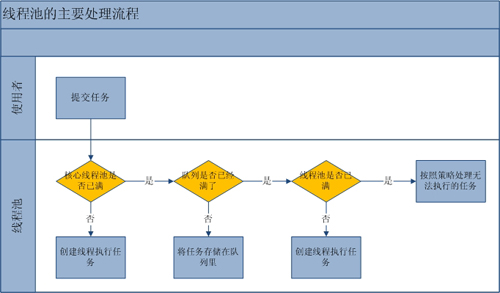本文对比的谈论了ES线程池(EsExecutors)和JVM线程池(Executors)的区别。
一、前言
其实就是在java.util.concurrent.ThreadPoolExecutor基础上做了封装,我们就看下和JVM线程池的区别。
二、Executors and EsExecutors
2.1 首先先看JVM线程池
注意:如果 corePoolSize < workerNum < maximumPoolSize时 是优先入队列的,队列满才addWorker。

2.2 对比的看都是如何对ThreadPoolExecutor进行的构造
- 以下为JVM线程池
1 | public static ExecutorService newFixedThreadPool(int nThreads) { |
- 以下为ES线程池
1 | public static EsThreadPoolExecutor newFixed(String name, int size, int queueCapacity, ThreadFactory threadFactory) { |
- 区别于差异
1) fixed(无限制)
- 使用SizeBlockingQueue(内部封装了LinkedTransferQueue无锁队列)代替LinkedBlockingQueue。
- ES 当
queueCapacity<0 时队列设为无界。
2) cached(定长)
- 同jvm
cachedThreadPool一样,只是拒绝策略自定义了EsAbortPolicy代替默认的AbortPolicy。其实由于
maximumPoolSize是MAX,所以基本不会发生拒绝(addWorker失败)。
3) scaling(可变大小)
- 这里创建的是一个无限制的queue,并且pool size的大小在最小最大值之间浮动。对于reject的处理是ForceQueuePolicy,即是将之放入queue中,这里的queue是无限制的。
es中可以通过GET /_cat/thread_pool来查看线程池状态信息。
二、es中使用的线程池
CACHED
- GENERIC:通用的操作,比如node的discovery,上面也说了,默认keep alive时间是5min;
FIXED
- LISTENER:主要用作java client的执行,默认大小halfProcMaxAt10;
- GET:用作get操作,默认大小availableProcessors,queue_size为1000;
- INDEX:用作index或delete操作,默认大小availableProcessors,queue_size为200;
- BULK:用作bulk操作,默认大小为availableProcessors,queue_size为50;
- SEARCH:用作count或是search操作,默认大小((availableProcessors * 3) / 2) + 1;queue_size为1000;
- SUGGEST:用作suggest操作,默认大小availableProcessors,queue_size为1000;
- PERCOLATE:用作percolate,默认大小为availableProcessors,queue_size为1000;
- FORCE_MERGE:用作force_merge操作(2.1之前叫做optimize),默认大小为1;
SCALING
- MANAGEMENT:用作ES的管理,比如集群的管理;默认大小5,keep alive时间为5min;
- FLUSH:用作flush操作,默认大小为halfProcMaxAt5,keep alive时间为5min;
- REFRESH:用作refresh操作,默认大小为halfProcMaxAt10,keep alive时间为5min;
- WARMER:用作index warm-up操作,默认大小为halfProcMaxAt5,keep alive时间为5min;
- SNAPSHOT:用作snapshot操作,默认大小为halfProcMaxAt5,keep alive时间为5min;
- FETCH_SHARD_STARTED:用作fetch shard开始操作,默认大小availableProcessors * 2,keep alive时间为5min;
- FETCH_SHARD_STORE:用作fetch shard存储操作,默认大小availableProcessors * 2,keep alive时间为5min;